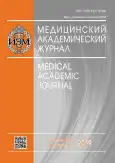ВЛИЯНИЕ ИНТРАНАЗАЛЬНОГО ВВЕДЕНИЯ БАКТЕРИАЛЬНОГО ЭНДОТОКСИНА НА ЭКСПРЕССИЮ АЛЬФА-СИНУКЛЕИНА В ПЕРИФЕРИЧЕСКИХ СТРУКТУРАХ ОЛЬФАКТОРНОЙ СИСТЕМЫ
- Авторы: Сергеева ТН1, Сергеева КС1
-
Учреждения:
- ФГБОУ ВО «Удмуртский государственный университет»
- Выпуск: Том 19, № 1S (2019)
- Страницы: 103-104
- Раздел: Статьи
- Статья опубликована: 15.12.2019
- URL: https://journals.eco-vector.com/MAJ/article/view/19348
- ID: 19348
Цитировать
Полный текст
Аннотация
Обонятельная дисфункция при идиопатической болезни Паркинсона (БП) позволила предположить так называемую «гипотезу обонятельного вектора», утверждающую, что БП возникает в результате переноса вируса или химического агента в ЦНС через обонятельные пути, что ведет к активации глиальных клеток и последующему повреждению дофаминовых нейронов. Ранее разработанная модель хронической прогрессирующей БП у мышей с интраназальным введением липополисахарида (ЛПС) продемонстрировала несколько ключевых особенностей ранней стадии БП: прогрессирующую гипокинезию, избирательную потерю дофаминовых нейронов, снижение содержания дофамина в полосатом теле и накопление и агрегацию α-синуклеина (α-syn) в черной субстанции головного мозга. Другая модель БП на основе назальной инокуляции агрегатами α-syn также демонстрировала паркинсоноподобные поведенческие и иммунологические особенности. Мы предполагаем, что интраназальное введение ЛПС приводит к увеличению экспрессии и неправильному фолдингу α-syn в обонятельных рецепторных клетках, проецируемых в обонятельные луковицы. Нами продемонстрировано увеличение экспрессии нативной и фосфорилированной форм иммунореактивного α-syn в обонятельных луковицах, где также наблюдались активированные глиальные клетки. Полученные результаты позволяют сделать вывод, что бактериальные антигены могут вызывать признаки, соответствующие паркинсонизму, вызывая глиальный нейровоспалительный ответ, а также путем увеличения продукции фосфорилированного α-syn в периферических структурах обонятельной системы.
Ключевые слова
Полный текст
Об авторах
Т Н Сергеева
ФГБОУ ВО «Удмуртский государственный университет»
К С Сергеева
ФГБОУ ВО «Удмуртский государственный университет»
Список литературы
Дополнительные файлы







